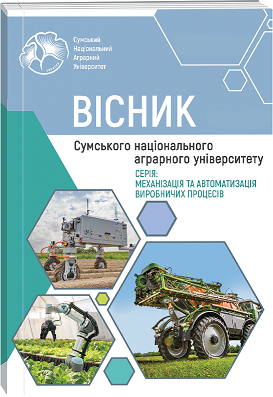INFLUENCE OF TECHNOLOGICAL PARAMETERS THE ELECTROCHEMICAL CHROMIATION PROCESS ON THE OPERATIONAL PROPERTIES OF COATINGS
Abstract
The analysis of chrome plating methods to increase the wear-resistance and corrosion resistance of replaceable parts of the hydraulic part of piston pumps: piston rods, rod extensions, plungers and cylinder bushings. Reasoned the advantages of using electrochemical chrome plating of parts in a flowing electrolyte with nanoadditives, which provides wear-resistant coatings with stable surface quality indicators and high physical and mechanical properties. An automated control system has been developed which provides maintain at a given level the technological parameters of the electrochemical chromium plating process in a flowing electrolyte: the ratio of concentrations of electrolyte components, flow rate, current density and electrolyte temperature, and also allows to control the value of the water index of the electrolyte and its electrical resistance. The application of a chromium coating of a standard electrolyte with nanoadditives on the 40HN steel samples, which were surface hardened and ground, have investigated. Surface roughness, thickness and microhardness of coating were determined. Chrome-plated samples were tested for wear during reciprocating motion. The value of wearing was determined by gravimetric method. Statistical results of the experiment were performed using correlation-regression analysis. The effect of mass ratio of concentrations of electrolyte components, current density, electrolyte flow rate and electrolyte temperature on the value of roughness, microhardness and wear of coatings was investigated. Second-order regression models that describe the dependences of the surface roughness, microhardness and wear of chrome coatings on the technological parameters of the process was constructed. Increasing a ratio of the concentrations of the electrolyte components, flow rate and current density leads to a decrease in roughness, and an increase in the electrolyte temperature causes an increase in the roughness of the chromium coating was established. Technological parameters of the chromium plating process have almost the same effect on increasing the microhardness and reducing the wear of the coating, and the introduction of aluminum nanooxides in the chromium coating leads to an increase in its microhardness and, accordingly, reduce wear.
References
2. Zhang, N., Huang, C. H., Zhang, C. H., & Shi, N. (2013). Anticorrosion Property Study on the Hard Chrome Plating Layer of Hydraulic Cylinder Rod. Advanced Materials Research, 791–793, 394–397. Trans Tech Publications, Ltd. ULR: https://doi.org/10.4028/www.scientific.net/amr.791-793.394.
3. Ma, J.-s. (2018). The law of barrel wear and its application. Defence Technology, 14 (6), 674–676. ULR: https://doi.org/10.1016/j.dt.2018.06.012.
4. Li, X.-l., Zang, Y., Lian, Y., Ma, M.-yu., Mu, L., & Qin, Q. (2021). An interface shear damage model of chromium coating/steel substrate under thermal erosion load. Defence Technology, 17(2), 405–415. ULR: https://doi.org/10.1016/j.dt.2020.02.002.
5. Yusron, R.M., Bisono, R.M., & Pramudia, M. (2020). Effect Electrolyte Temperature and Electrode Distance to Electroplating Hard-Chrome on Medium-Carbon Steel. Journal of Physics: Conference Series, 1569 (4), art. no. 042007. ULR: https://doi.org/10.1088/1742-6596/1569/4/042007.
6. Jeeva, P.A. (2020). A review on electrodeposition of hard chrome plating. Journal of Corrosion Science and Engineering, 23, art. no. 41, 1–12.
7. Galimov, D.M., Ardashev, D.V., & Dyakonov, A.A. (2020). Morphology and properties of solid chrome plating, obtained by the galvano-mechanical method. Solid State Phenomena, 299 SSP, 872–878. ULR: https://doi.org/10.4028/www.scientific.net/SSP.299.872.
8. Vinh, P.N., Thien, N.D., Le & Chi, C. (2018). Study the Effect of Chrome Coating Thickness to Fatigue Strength of the Axle-Shaped Machine Parts. Proceedings 2018 4th International Conference on Green Technology and Sustainable Development, GTSD 2018, art. no. 8595550, 221–226. ULR: https://doi.org/10.1109/GTSD.2018.8595550.
9. Ngon, D.T., Cuong, L.C., & Phoi, N.V. (2016). Study of the Effect of Chrome Coating Layer to the Fatigue Strength of the Axial Machine Parts. Proceedings – 3rd International Conference on Green Technology and Sustainable Development, GTSD 2016, art. no. 7796635, 135–140. https://doi.org/10.1109/GTSD.2016.40.
10. Xia, H., Shen, X.M., Yang, X.C., Xiong, Y., & Jiang, G.L. (2018). Influences of the current density on the performances of the chrome-plated layer in deterministic electroplating repair. IOP Conference Series: Materials Science and Engineering, 292 (1), art. no. 012075. ULR: https://doi.org/10.1088/1757-899X/292/1/012075.
11. Danilov, F.I., Protsenko, V.S., Gordiienko, V.O., Baskevich, A.S., & Artemchuk, V.V. (2013). Electroplating of wearresistant nanocrystalline coatings from a bath containing basic chromium (III) sulfate (chrome tanning agent). Protection of Metals and Physical Chemistry of Surfaces, 49 (3), 299–303. ULR: https://doi.org/10.1134/S2070205113030076.
12. Protsenko, V.S., & Danilov, F.I. (2014). Chromium electroplating from trivalent chromium baths as an environmentally friendly alternative to hazardous hexavalent chromium baths: Comparative study on advantages and disadvantages. Clean Technologies and Environmental Policy, 16 (6), 1201–1206. ULR: https://doi.org/10.1007/s10098-014-0711-1.
13. Protsenko, V.S., Bobrova, L.S., Baskevich, A.S., Korniy, S.A., & Danilov, F.I. (2018). Electrodeposition of chromium coatings from a choline chloride based ionic liquid with the addition of water. Journal of Chemical Technology and Metallurgy, 53 (5), 906–915.
14. Bakanov, V.I., Nesterova, N.V., & Yakupov, A.A. (2017). Features of electroplating of nanocrystalline chromium coatings from electrolytes based on Cr(III). Protection of Metals and Physical Chemistry of Surfaces, 53 (3), 426–432. ULR: https://doi.org/10.1134/S2070205117030054.
15. Katirci, R. (2016). A chrome coating from a trivalent chromium bath containing extremely low concentration of Cr3+ ions. International Journal of Surface Science and Engineering, 10(1), 73–85. ULR: https://doi.org/10.1504/IJSURFSE.2016.075318.
16. Liang, A., Li, Y., Liang, H., Ni, L., & Zhang, J. (2017). A favorable chromium coating electrodeposited from Cr(III) electrolyte reveals anti-wear performance similar to conventional hard chromium. Materials Letters, 189, 221–224. ULR: https://doi.org/10.1016/j.matlet.2016.12.022.
17. Hall, T. D., Snyder, S. T., Taylor, E. J., Inman, M. E., Xu, J., & Radhakrishnan, R. (2017). Development of a Functional Reach Compliant Trivalent Chromium Electroplating Process. ECS – 2017 The Electrochemical Society, ECS Meeting Abstracts, E01-Green Electrodeposition, 4, MA2017-01, art. no. 1045. ULR: https://doi.org/10.1149/MA2017-01/18/1045.
18. Qi, J., Światowska, J., Skeldon, P., & Marcus, P. (2020). Chromium valence change in trivalent chromium conversion coatings on aluminium deposited under applied potentials. Corrosion Science, 167, art. no. 108482. ULR: https://doi.org/10.1016/j.corsci.2020.108482.
19. Sherwin, C., Bhat, S., & Hebbar, S. P. (2020). A brief review on nickel and chromium coatings developed by electrochemical routeю. AIP Conference Proceedings, 2236 (1), art. no. 040007. ULR: https://doi.org/10.1063/5.0006832.
20. Putri, S., Pujiyanto, E., & Triyono, J. (2019). Optimization of Electroplating Thickness Quality at Hip Joint Implant Using the Taguchi Method. Jurnal Teknik Industri, 20(1), 45–52. ULR: https://doi.org/10.22219/JTIUMM.Vol20.No1.45-52.
21. Bikulčius, G., Češunienė, A., Selskienė, A., Pakštas, V., & Matijošius, T. (2017). Dry sliding tribological behavior of Cr coatings electrodeposited in trivalent chromium sulphate baths. Surface and Coatings Technology, 315, 130–138. ULR: https://doi.org/10.1016/j.surfcoat.2017.01.076.
22. Addach, H., Berçot, P., Rezrazi, M., Petris-Wery, M. De., & Ayedi, H. F. (2007) Application of statistical design to optimisation of hardness and hydrogen content of chromium coating under pulse reverse electroplating, Transactions of the Institute of Metal Finishing. The International Journal of Surface Engineering and Coatings, 85(4), 187–193. ULR: https://doi.org/10.1179/174591907X216422.
23. Kagajwala, B., Hall, T.D., Inman, M., Taylor, E.J., Griffin, B., Cushnie, G., Taylor, R., Jaworowski, M., & Bonivel, J. (2013). Functional Trivalent Chromium Electroplating of Internal Diameters. Products Finishing, 1/2/2013. Digital Edition. ULR: https://www.pfonline.com/articles/functional-trivalent-chromium-electroplating-of-internal-diameters.
24. Ropiak L. Ia. & Ostapovych V. V. (2016). Optymizatsiia tekhnolohichnykh parametriv protsesu khromuvannia dlia zabezpechennia pokaznykiv yakosti detalei porshnevykh nasosiv. Skhidno-Evropeiskyi zhurnal peredovykh tekhnolohii [Eastern-European Journal of Enterprise Technologies], 2 (5 (80), 50–62. (in Ukrainian). ULR: https://doi.org/10.15587/1729-4061.2016.65719.
25. Belyaev, V. N., Koslyuk, A. Yu, Lobunets, A. V., & Andreyev, A. S. (2016). Quality Improvement of Chrome-Diamond Coatings on Flowing Chrome Plating. IOP Conference Series: Materials Science and Engineering, 126 (1), art. no. 012002. ULR: https://doi.org/10.1088/1757-899X/126/1/012002.
26. Sonntag, R., Feige, K., dos Santos, C.B., & Kretzer, J.P. (2017). Hard chrome-coated and fullerene-doped metal surfaces in orthopedic bearings. Materials, 10 (12), art. no. 1449. ULR: https://doi.org/10.3390/ma10121449.
27. Yar-Mukhamedova, G., & Yar-Mukhamedov, E. (2012). Investigation of corrosion resistance of chrome based nano-composition coatings in the conditions of oil production. 12th International Multidisciplinary Scientific GeoConference and EXPO – Modern Management of Mine Producing, Geology and Environmental Protection, SGEM 2012, 3, 475–479.
28. Bikulčius, G., Češūnienė, A., Selskienė, A., Grigucevičienė, A., Jasulaitienė, V., & Ger, M. (2018). Characterization of Cr–ZrO2 composite coatings electrodeposited from Cr(III) bath. Chemija, 29 (2), 97–108. ULR: https://doi.org/10.6001/chemija.v29i2.3712.
29. Zeng, Z., & Zhang, J. (2008). Electrodeposition and tribological behavior of amorphous chromium-alumina composite coatings. Surface and Coatings Technology, 202(12), 2725–2730. ULR: https://doi.org/10.1016/j.surfcoat.2007.10.008.
30. Bloch, H. P., & Geitner, F. K. (2019). Chapter 10 – Protecting machinery parts against the loss of surface. Editor(s): Heinz P. Bloch, Fred K. Geitner. In Practical Machinery Management for Process Plants. Machinery Component Maintenance and Repair (Fourth Edition). Gulf Professional Publishing, 2019, 551–633. ULR: https://doi.org/10.1016/B978-0-12-818729-6.00010-1.

 ISSN
ISSN  ISSN
ISSN 



